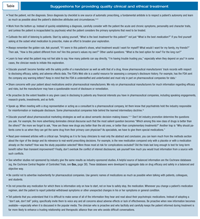Publication
Article
Psychiatric Times
Undue Pharmaceutical Influence on Psychiatric Practice
Author(s):
Questions have also been raised about the extent of industry influence on the American Psychiatric Association’s diagnostic and treatment guidelines-namely, its DSM and Clinical Practice Guidelines.

Within the past few years, increasing concerns have arisen about the ways in which corporate sponsorship of clinical trials and continuing medical education activities may bias the information that is published and disseminated about the benefits and risks of medications. 1,2 Questions have also been raised about the extent of industry influence on the American Psychiatric Association’s diagnostic and treatment guidelines-namely, its DSM and Clinical Practice Guidelines.3,4
Clinicians are not the only ones concerned about the effect of financial conflicts of interest on health care. As controversy over the current revision of DSM has spread to the popular media, patients may also have questions-regardless of whether they articulate them.
What is at stake is the strength and effectiveness of the therapeutic alliance, since the perception, let alone the reality, of bias will likely erode trust and lead to a diminished response to the clinician and to treatment. Although pharmaceutical marketing practices have received much attention in recent years, there are more insidious, but just as powerful, ways in which clinicians may be receiving misinformation. It is in patients’ and clinicians’ best interest to maintain a healthy dose of skepticism when reviewing any data on the efficacy and safety of psychotropic medications, however prestigious the source. Also, healthy skepticism should not be conflated with an antimedication approach and certainly not with therapeutic nihilism.
Clearly, there exists the potential for bias and misinformation in an industry-dominated climate. However, a psychiatrist’s treatment of patients need not be undermined by public controversy over the actions of corporations or professional organizations.
This article explores some of the ethical dilemmas that can arise in today’s challenging climate. In addition, psychiatrists’ responses to the growing distrust of patients are discussed.
Randomized clinical controlled trials
Randomized clinical trials are described as the gold standard for evaluating the efficacy and safety of medications. However, this gold standard is sometimes compromised because of inadequate methodological design and outcome measures; use of effect sizes that are not clinically meaningful; failure to report adverse effects; and violation of equipoise, which lead to the approval of “me-too” drugs that are not safer, less expensive, or more effective than medications already on the market.5-8 The brief duration of some clinical trials (often 6 to 8 weeks) does not permit sound judgments about long-term efficacy and safety. Industry sponsorship tends to be associated with proindustry conclusions, even when those conclusions are not necessarily warranted.5,6 Thus, convergent validity, ie, the use of different methods, including challenge/dechallenge case reports, is vital in considering pharmaceutical safety.
Physicians employed by industry as clinical trial and safety directors have an obligation-per universal principles of medical ethics as well as the AMA code of ethics-to design, implement, and report clinical trials in a scientifically responsible manner.9,10 Nonetheless, the actions of some pharmaceutical companies have raised the question about whether the benefits of antidepressants and atypical antipsychotics are overemphasized and the risks underreported. One study of clinical trials of psychiatric medications found that “among the 162 randomized, double-blind, placebo-controlled studies examined, those that reported conflict of interest were 4.9 times more likely to report positive results.”11
Antidepressants and atypical antipsychotics
A recently published meta-analysis of the efficacy of antidepressants found that “the magnitude of benefit of antidepressant medication compared with placebo increases with severity of depression symptoms and may be minimal or nonexistent, on average, in patients with mild or moderate symptoms.”12 A research team that previously conducted a meta-analysis drew an even stronger conclusion: “the relationship between initial severity and antidepressant efficacy is attributable to decreased responsiveness to placebo among very depressed patients rather than increased responsiveness to medication [authors’ italics].”13 Moreover, pharmaceutical manufacturers do not have an incentive to ask whether the drugs they produce may have adverse effects.14
Similarly, the assumed superiority of atypical antipsychotics has been called into question. Several large multicenter studies in both the United States and the United Kingdom, as well as meta-analyses, have raised questions about the validity of differentiating between typical and atypical antipsychotics because no “differences in quality of life or effectiveness measures” between the 2 classes of drugs were found.15 Indeed, there is growing evidence that atypical antidepressants and antipsychotics are not advantageous for many patients (although they are properly prescribed for some), and there is increasing evidence of the persistence of adverse effects (eg, sexual dysfunction, type 2 diabetes mellitus) even after the medications are discontinued. The fact that prescription patterns have not changed reflects not only a triumph of marketing but also the strength of decision-making biases.15,16
CHECKPOINTS
? Clinicians are not the only ones concerned about the effect of financial conflicts of interest on health care-patients may also have questions, regardless of whether they articulate them.
? It is in patients’ and clinicians’ best interest to maintain a healthy dose of skepticism when reviewing any data on the efficacy and safety of
psychotropic medications, however prestigious the source.
? Practitioners who read and later recall guidelines typically remember the general recommendations but forget the detailed exceptions and qualifications-indications and benefits are more likely to be remembered than warnings and contraindications buried in the adverse events section.
DSM and Clinical Practice Guidelines are not immune to industry influence
DSM is often mischaracterized as the bible of psychiatric disorders because of its enormous influence on clinical practice. As with previous editions of DSM, the proposed revisions for DSM5 give little attention to adverse effects. Only 2 of more than 700 pages of text of the main body of DSM-IV-TR deal with diagnosing adverse effects of psychotropic medications, and there the focus is on movement disorders. Neuroleptic malignant syndrome is given short shrift (1 paragraph). A discussion of life-threatening adverse effects such as diabetes and other metabolic conditions is entirely absent. A review of the recently proposed changes to DSM (www.dsm5.org) indicates that these omissions will remain in the next edition. Approximately 68% of the DSM5 task force report having ties to the pharmaceutical industry.17 This represents an increase of 20% over the proportion of DSM-IV task force members with such ties.17,18
Clinical Practice Guidelines, which are used by primary care physicians as well as mental health clinicians, exert enormous influence on psychiatric treatment. It is thus imperative that the recommendations be balanced and accurate, and that they give adequate consideration to informed consent, alternatives to medications, and information about when to discontinue medications. However, all of the authors of the Clinical Practice Guidelines for bipolar disorder, for example, had financial relationships with companies whose drugs were identified as “first-line pharmacological treatment.”3 Not surprisingly, there is little discussion of how to inform patients of the risks and benefits of medications, when to discontinue medications, or how to monitor patients for withdrawal symptoms in the Clinical Practice Guidelines.
Deeper implications for psychiatric practice
People being treated for serious mental illness are often highly vulnerable to distrust. The fear of psychosis and the hopelessness and helplessness of severe depression can diminish a patient’s ability to weigh treatment risks, benefits, and alternatives. Such challenges do not mean that patients cannot navigate complex decision-making processes and that psychiatrists must resort to a paternalistic model of care.19,20 Patients who believe that their prescribing clinician has their best interests at heart are better able to engage in shared decision making. A therapeutic alliance grounded in trust is essential in bringing strength and hope to the lives of individuals with psychiatric disabilities. When a patient has been informed about the potential adverse effects of a medication, there is a better chance that he or she will trust the clinician, will adhere to the medication regimen, and will be receptive to other treatment trials than will a patient for whom a bad outcome is a devastating surprise.
Beyond the biases that influence the formulation of treatment guidelines, practitioners who read and later recall those guidelines typically remember the general recommendations but forget the detailed exceptions and qualifications.21 Warnings and contraindications buried in the adverse events section of the labeling of a pharmaceutical product are not likely to be as well-remembered as the indications and benefits that are prominently noted. The consequences of automated thinking and the irrational persistence in belief may be reinforced by delays in disclosing adverse effects of medications.21,22 Once clinicians have internalized the mindset that a particular drug is the treatment of choice for a particular condition, the automatic prescribing habit sets in and becomes difficult to dislodge. As a result, a pharmaceutical company that engages in such tactics of habituation gains an unfair competitive advantage over a competitor that makes full and timely disclosures of adverse findings.
Recommendations
Although practicing evidence-based medicine can be a useful corrective to uncritical prescribing, it is no panacea. Unavoidably, we practice under conditions of uncertainty, where every patient exists in a unique life context, every patient-clinician relationship is in some ways unique, and the next clinical outcome cannot be known until it occurs.23 Yet this very complexity, to which potential or real financial conflicts of interests contribute, presents an opportunity to enhance and strengthen the therapeutic alliance through a mix of clinical wisdom and humility.

The suggestions given in the Table were developed by soliciting feedback from individuals who represented a range of disciplines and perspectives. For example, some were social scientists who have publicly questioned the ethics of industry-funded research, while others were clinicians and academicians who received honoraria for talks sponsored by pharmaceutical companies, or who received funding for their research. Incorporating feedback from a wide variety of individuals-both critics of financial conflicts of interest and those with industry ties-may serve as a model for how professional orga-nizations such as the American Psychiatric Association can better manage collaborations between industry and academic institutions and medical schools. Specifically, the goal should be to achieve a meaningful system of checks and balances. Thus, rather than a ban on individuals with industry ties serving on panels of diagnostic and treatment guidelines, perhaps a more helpful solution would be to invite critics of industry to serve alongside individuals who have connections to pharmaceutical companies.
References:
References
1.
Als-Nielsen B, Chen W, Gluud C, Kjaergard LL. Association of funding and conclusions in randomized drug trials: a reflection of treatment effect or adverse events?
JAMA.
2003;290:921-928.
2.
Brodkey AC. The role of the pharmaceutical industry in teaching psychopharmacology: a growing problem.
Acad Psychiatry
. 2005;29:222-229.
3.
Cosgrove L, Krimsky S, Vijayaraghavan M, Schneider L. Financial ties between DSM-IV panel members and the pharmaceutical industry.
Psychother Psychosom.
2006;75:154-160.
4.
Cosgrove L, Bursztajn HJ, Krimsky S, et al. Conflicts of interest and disclosure in the American Psychiatric Associations’ Clinical Practice Guidelines.
Psychother Psychosom.
2009;78:228-232.
5.
Angell M.
The Truth About Drug Companies: How They Deceive Us and What to Do About It
. New York: Random House; 2004.
6.
Bekelman JE, Li Y, Gross CP. Scope and impact of financial conflicts of interest in biomedical research: a systematic review.
JAMA.
2003;289:454-465.
7.
Pitrou I, Boutron I, Ahmad N, Ravaud P. Reporting of safety results in published reports of randomized controlled trials.
Arch Intern Med.
2009;169:1756-1761.
8.
Djulbegovic B, Lacevic M, Cantor A, et al. The uncertainty principle and industry-sponsored research.
Lancet
. 2000;356:635-638.
9.
National Institutes of Health. Regulations and Ethical Guidelines.
http://ohsr.od.nih.gov/guidelines/nuremberg.html
. Accessed March 23, 2010.
10.
Pincus HA, Lieberman JA, Ferris S, eds.
Ethics in Psychiatric Research: A Resource Manual for Human Subjects Protection
. Washington, DC: American Psychiatric Association; 1999.
11.
Perlis RH, Perlis CS, Wu Y, et al. Industry sponsorship and financial conflict of interest in the reporting of clinical trials in psychiatry.
Am J Psychiatry.
2005;162:1957-1960.
12.
Fournier JC, DeRubeis RJ, Hollon SD, et al. Antidepressant drug effects and depression severity: a patient-level meta-analysis.
JAMA
. 2010;303:47-53.
13.
Kirsch I, Deacon BJ, Huedo-Medina TB, et al. Initial severity and antidepressant benefits: a meta-analysis of data submitted to the Food and Drug Administration.
PLoS Med.
2008;5:e45.
14.
Davis D.
The Secret History of the War on Cancer
. New York: Basic Books; 2007.
15.
Makhinson M. Biases in medication prescribing: the case of second generation antipsychotics.
J Psychiat Pract.
2010;16:15-21.
16.
Hamm RM. Conflicts of interest and evidence-based clinical medicine. In: Kattan MW, ed.
Encyclopedia of Medical Decision Making
. Vol 1
.
Thousand Oaks, CA: Sage Publications; 2009:171-175.
17.
Cosgrove L, Bursztajn H, Krimsky S. Developing unbiased diagnostic and treatment guidelines in psychiatry.
N Engl J Med.
2009;360:2035-2036.
18.
Cosgrove L, Bursztajn HJ. Pharmaceutical philanthropic shell games.
Psychiatr Times
. 2010;27(3):20.
19.
Deegan PE, Drake RE. Shared decision making and the medication management in the recovery process.
Psychiatr Serv.
2006;57:1636-1639.
20.
Perlin ML, Bursztajn H, Gledhill K, Szeli E. Psychiatric Ethics and the Rights of Persons With Mental Disabilities in Institutions and in the Community. United Nations Educational Scientific and Cultural Organization (UNESCO, Chair in Bioethics); 2008.
http://portal.unesco.org/shs/en/ev.php-URL_ID=11800&URL_DO=DO_TOPIC&URL_SECTION=201.html
. Accessed March 23, 2010.
21.
Hamm RM. Automatic thinking. In: Kattan MW, ed.
Encyclopedia of Medical Decision Making
. Vol 1
.
Thousand Oaks, CA: Sage Publications; 2009:45-49.
22.
Hamm RM. Irrational persistence in belief. In: Kattan MW, ed.
Encyclopedia of Medical Decision Making
. Vol 2
.
Thousand Oaks, CA: Sage Publications; 2009:640-644.
23.
Bursztajn HJ, Feinbloom RI, Hamm RM, Brodsky A.
Medical Choices, Medical Chances : How Patients, Families, and Physicians Can Cope With Uncertainty
. New York: Routledge; 1990.
24.
Cosgrove L, Bursztajn H. Undoing undue industry influence: lessons from psychiatry as psychopharmacology.
J Org Ethics
. 2006;3:131-133.
25.
Andreasen NC. DSM and the death of phenomenology in America: an example of unintended consequences.
Schizophr Bull
. 2007;33:108-112.
26.
Abaray JG, Kern E. Modern realities render the learned intermediary doctrine obsolete.
Products Liability.
2010;1:13-15.
www.burgsimpson.com/pdf/AbarayKernArticle.pdf
. Accessed March 29, 2010.
27.
Applbaum K. Getting to yes: corporate power and the creation of a psychopharmaceutical blockbuster.
Cult Med Psychiatry.
2009;33:185-215.
28.
Shaughnessy AF, Slawson DC, Bennett JH. Separating the wheat from the chaff: identifying fallacies in pharmaceutical promotion.
J Gen Intern Med.
1994;9:563-568.
29.
Spielmans GI, Parry PI. From evidence-based medicine to marketing-based medicine: evidence from internal industry documents.
J Bioeth Inquiry.
2010;7:13-29. doi:10.1007/s11673-010-9208-8. Accessed March 29, 2010.
30.
Bursztajn HJ, Chanowitz B, Kaplan E, et al. Medical and judicial perceptions of the risks associated with the use of antipsychotic medication.
Bull Am Acad Psychiatry Law
. 1991;19:271-275.
31.
Bursztajn HJ, Chanowitz B, Gutheil TG, Hamm RM. Micro-effects of language on risk perception in drug prescribing behavior.
Bull Am Acad Psychiatry Law
. 1992;20:59-66.







